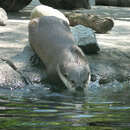Biology
(
Inglês
)
fornecido por Arkive
Within its aquatic habitat, the African clawless otter searches for food with its dexterous hands, overturning rocks, churning up mud, and probing vegetation for crustaceans, molluscs, frogs, fish and water tortoises (4) (5). Once captured, the otter may float in the water whilst eating its prey, or take larger items ashore (4). Often this activity is undertaken solitary, but sometimes groups of up to eight African clawless otters may be seen, usually either a mother with her cubs, or a group of males (4).
African clawless otters use a number of sites out of the water to rest and sleep. Often these may be situated amongst thick vegetation or amid rocks, but they may also dig underground dens that are up to three metres long and contain a grass-lined nest (4). This otter may breed at any time of the year, giving birth to a litter of one to three cubs after a gestation of 63 days. At just one year of age, the young African clawless otters are independent (4).
African clawless otters leave a number of noticeable clues to their presence as they move about their habitat. The large, long, clawless footprints are unmistakable, and deposits of faeces and urine are often left as they travel as a means of communicating with other otters. The African clawless otter also emits a variety of whistles, huffs, growls and screams with which it communicates to other individuals (4).
Conservation
(
Inglês
)
fornecido por Arkive
Despite the rather numerous threats facing this species in certain parts of its range, none are believed to be great enough to result in the African clawless otter being threatened with extinction (1). It has been recorded in degraded river habitats, where there are high levels of pollution or eutrophication, as well as in towns and cities (1), which demonstrates that this species may have some resilience to man-made changes to its habitat. The African clawless otter also occurs in a number of protected areas across its range (1).
Description
(
Inglês
)
fornecido por Arkive
The dexterous, hand-like forefeet of the African clawless otter are its most remarkable feature, enabling it to grapple with its prey with notable ease. The forefeet have long fingers, rounded finger tips and, as its name describes, lack any claws (4) (5). The hindfeet are also clawless, but unlike the forefeet, have webbing between the digits (5). Also making the African clawless otter a proficient predator is its large skull, which houses powerful jaws and large, broad molars with which to crush its prey (2) (4). The sleek coat of this large otter is dark chocolate brown on the upperparts, lighter below, and creamy white on the throat (2) (4), and numerous conspicuous white whiskers frame the face (4).
Habitat
(
Inglês
)
fornecido por Arkive
The African clawless otter is an inhabitant of a wide range of freshwater habitats, including lakes, streams, rivers and estuaries (5). It may also be found in marine habitats, such as along rocky seashores if there is access to freshwater, which is essential for drinking and washing (1) (4). Although most often found in water, the African clawless otter is also capable of travelling long distances overland (4).
Range
(
Inglês
)
fornecido por Arkive
The most widely distributed otter in Africa, the African clawless otter ranges from Senegal, through most of West Africa to Ethiopia, and south to South Africa (1). Overall, it may occur in any large areas of suitable habitat south of the Sahara, except for the Congo Basin (4).
Status
(
Inglês
)
fornecido por Arkive
Classified as Least Concern (LC) on the IUCN Red List (1) and listed on Appendix II of CITES (3). Populations of the subspecies Aonyx capensis microdon in Cameroon and Nigeria are listed on Appendix I of CITES (3).
Threats
(
Inglês
)
fornecido por Arkive
In some areas of its large range, the African clawless otter is killed for its sleek fur, or for other body parts that are used in traditional medicines (1) (4). It may also be persecuted due to the belief that this otter competes for fish with humans, or because it is blamed for the death of domestic ducks, hens, or the raid of a fish farm (1) (4). Occasionally, African clawless otters may occasionally become entangled in fishing nets, and drown (1).
The African clawless otter may also be impacted in some areas by the degradation or loss of its habitat. Deforestation, development, overgrazing, the draining of wetlands, and water extraction all have a detrimental impact on the quality of its aquatic habitat and the surrounding vegetation (1) (4).

